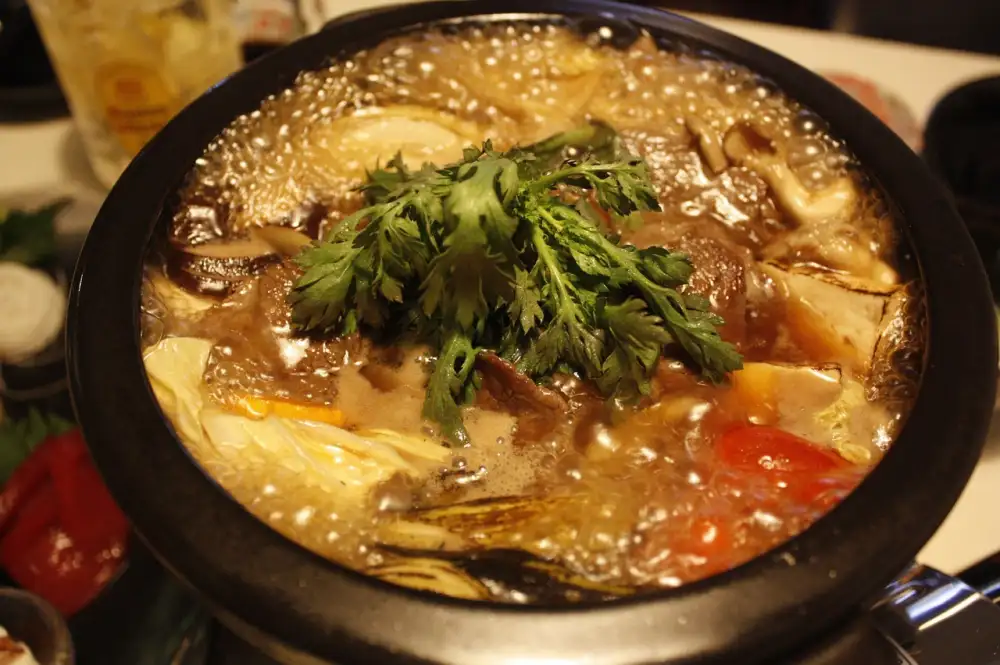Hotpot Delights: Discover the Joy of Simmering Chinese Cuisine at Your Table

Hotpot, also known as Chinese fondue, is a beloved culinary tradition that brings people together around a simmering pot of broth. It is a communal dining experience where friends and family gather to cook an assortment of fresh ingredients at the table. This interactive and flavorful meal is not only delicious but also a source of joy and connection. Whether you're seeking warmth on a chilly evening or simply looking for a unique dining experience, hotpot offers a delightful journey into the heart of Chinese cuisine.
History and Origins of Hotpot
Hotpot, also known as Chinese fondue, has a rich history that dates back over 1,000 years. Its origins can be traced to the Jin Dynasty in China. It was initially popularized by the Mongols who used a similar method of cooking during their conquests. The concept of communal dining and sharing a simmering pot of broth and ingredients quickly spread throughout China.
Over time, hotpot became an integral part of Chinese cuisine, with different regions developing their own unique variations. In Sichuan province, for example, the hotpot is known for its fiery and numbing flavors due to the generous use of Sichuan peppercorns and chili peppers. In contrast, Cantonese-style hotpot focuses on using fresh and delicate ingredients such as seafood and thinly sliced meats.
Hotpot's popularity has transcended borders and is now enjoyed worldwide. Its communal nature fosters a sense of togetherness and connection among diners. Whether it's a cozy family gathering or a lively social event with friends, hotpot brings people together to share a delicious meal while creating lasting memories.
Ingredients Used in Hotpot
When it comes to hotpot, the ingredients used play a crucial role in creating a flavorful and satisfying meal. The beauty of hotpot lies in its versatility, allowing you to customize your dining experience according to your preferences. Here are some common ingredients used in hotpot:
1. Meat: Thinly sliced beef, lamb, pork, and chicken are popular choices for hotpot. The marbled cuts of meat add richness and flavor to the broth as they simmer.
2. Seafood: Fresh seafood like prawns, fish balls, squid, and scallops bring a delightful oceanic taste to the hotpot. They cook quickly and absorb the flavors of the broth beautifully.
3. Tofu: Soft tofu or firm tofu is a staple in hotpot. It adds a silky texture and absorbs the flavors of the broth well.
4. Vegetables: Leafy greens such as spinach, bok choy, and Chinese cabbage are commonly added to hotpot for their freshness and crunchiness. Other vegetables like mushrooms, lotus root, and bean sprouts also make great additions.
5. Noodles: Thin rice noodles or glass noodles are often included in hotpot for a hearty carb component. They soak up the flavors of the broth while adding substance to each bite.
6. Dumplings: Dumplings filled with meat or vegetables can be cooked directly in the hotpot broth for an extra burst of flavor.
7. Dipping Sauces: A variety of dipping sauces can be prepared to enhance the flavors of your hotpot ingredients further. Common options include sesame sauce, soy sauce with garlic and chili oil, peanut sauce, or vinegar with minced garlic.
Remember that these are just some suggestions; feel free to experiment with different ingredients based on your personal taste preferences. The key is to have an array of ingredients that complement each other and create a harmonious balance of flavors in your hotpot experience
Types of Hotpot Broths
When it comes to hotpot, the broth is the heart and soul of this delicious Chinese cuisine. There are several types of hotpot broths, each with its own unique flavors and characteristics. Here are some popular options:
1. Spicy Sichuan Broth: This fiery broth is made with a combination of Sichuan peppercorns, dried chili peppers, garlic, and various spices. It's known for its numbing and spicy taste that will leave your taste buds tingling.
2. Clear Chicken Broth: This light and flavorful broth is made by simmering chicken bones with ginger, scallions, and other aromatics. It provides a clean base for cooking a variety of ingredients and allows their natural flavors to shine.
3. Mushroom Broth: Ideal for vegetarians or those looking for a lighter option, this broth is made by simmering an assortment of mushrooms like shiitake, oyster, or enoki. It imparts a rich umami flavor to the ingredients.
4. Tom Yum Broth: Originating from Thailand, this tangy and aromatic broth is made with lemongrass, kaffir lime leaves, galangal, chili peppers, and lime juice. It adds a refreshing kick to your hotpot experience.
5. Herbal Broth: This health-boosting broth is made by infusing various Chinese herbs like goji berries, astragalus root, ginseng, and jujubes into the soup base. It not only adds depth of flavor but also offers medicinal benefits.
6. Mala Broth: Hailing from the Sichuan province in China, mala broth combines the spiciness of chili peppers with the numbing sensation of Sichuan peppercorns. It creates a complex flavor profile that keeps you coming back for more.
These are just a few examples of the wide range of hotpot broths available. You can also find regional variations such as seafood broth, kimchi broth, or even cheese broth. The choice of broth depends on your personal preference and the ingredients you plan to cook in it. So, go ahead and explore the diverse world of hotpot broths to enhance your hotpot experience.
Cooking Process and Techniques
Hotpot is a unique dining experience that involves cooking various ingredients in a simmering broth right at your table. The process is simple yet delightful, allowing you to savor the flavors and textures of each ingredient as they cook to perfection.
To start, the hotpot is placed in the center of the table, filled with a flavorful broth of your choice. The broth can be mild or spicy, depending on your preference. As the broth heats up, it infuses with the ingredients, creating a rich and aromatic base for your hotpot.
Once the broth is simmering, it's time to add in the ingredients. Thinly sliced meats like beef, lamb, or pork are popular choices, along with seafood such as shrimp and fish balls. Vegetables like leafy greens, mushrooms, and tofu are also commonly added.
The cooking time varies depending on the ingredient. Thinly sliced meats only need a few seconds to cook while heartier vegetables require a bit more time. It's important to not overcook the ingredients to maintain their freshness and texture.
As each ingredient cooks, you can use chopsticks or small strainers to retrieve them from the hotpot. Dip them into various sauces like soy sauce, sesame oil, or chili paste for added flavor before enjoying.
One technique often used in hotpot is "dunking." This involves briefly submerging thinly sliced meat or vegetables into the boiling broth until cooked to your desired level of doneness. This quick cooking method ensures that each bite is tender and succulent.
Another technique is "swirling," where you gently stir the ingredients in the hotpot using chopsticks or ladles. This helps distribute flavors evenly throughout the broth and ensures that all ingredients are cooked thoroughly.
The beauty of hotpot lies in its interactive nature. It encourages conversation and sharing as everyone gathers around the pot to cook their own food. It's a communal experience that brings people together, creating lasting memories and joy.
So, gather your loved ones, prepare a hotpot feast, and immerse yourself in the delightful cooking process. Explore different ingredients, experiment with flavors, and enjoy the satisfaction of creating a delicious meal right at your table.
Popular Hotpot Variations
Hotpot is a versatile dish that can be customized to suit different tastes and preferences. Here are some popular variations of hotpot:
1. Sichuan Spicy Hotpot: Known for its fiery flavors, this variation uses a spicy broth made with Sichuan peppercorns, chili peppers, and various spices. It's perfect for those who enjoy a bold and intense taste.
2. Seafood Hotpot: This variation focuses on fresh seafood such as shrimp, fish, scallops, and clams. The broth is usually light and flavorful, allowing the natural sweetness of the seafood to shine through.
3. Mushroom Hotpot: Ideal for vegetarians or mushroom lovers, this variation features an assortment of mushrooms like shiitake, enoki, and oyster mushrooms. The broth is often made with mushroom stock for an earthy flavor.
4. Tomato Hotpot: A popular choice in many parts of China, this variation includes a tangy tomato-based broth. It's typically paired with ingredients like beef slices, tofu, vegetables, and noodles.
5. Lamb Hotpot: Commonly found in northern China, this variation uses tender lamb slices as the main protein. The broth is rich and hearty, often flavored with herbs like cumin and star anise.
These variations offer a glimpse into the diverse world of hotpot cuisine. Whether you prefer spicy or mild flavors, meat or vegetables, there's a hotpot variation that will satisfy your cravings and delight your taste buds.
Health Benefits of Hotpot
Hotpot not only delights your taste buds but also offers numerous health benefits. Firstly, it is a great way to incorporate a variety of vegetables into your diet, ensuring you get a good dose of vitamins and minerals. The simmering process retains the nutrients in the ingredients, making it a nutritious meal option.
Additionally, hotpot can be customized to suit different dietary needs. Whether you prefer lean meats, seafood, or plant-based protein sources like tofu and mushrooms, hotpot allows you to choose what goes into your broth.
The communal aspect of hotpot dining encourages social interaction and bonding with family and friends. This can contribute to improved mental well-being and reduced stress levels.
Furthermore, hotpot is a low-fat cooking method as excess fat from ingredients floats to the surface of the broth, allowing for easy removal. This makes it an ideal choice for those watching their weight or trying to maintain a healthy lifestyle.
Lastly, the hot broth aids digestion by increasing metabolism and promoting better nutrient absorption. The warm temperature of the soup can also provide relief from cold symptoms and soothe sore throats.
With its combination of wholesome ingredients and nourishing qualities, hotpot truly offers a delightful and healthy dining experience.
Tips for Enjoying Hotpot
1. Choose a variety of ingredients: To fully enjoy hotpot, select a diverse range of ingredients such as thinly sliced meats, fresh seafood, vegetables, tofu, and noodles. This will ensure a balanced and flavorful meal.
2. Dip and cook in small portions: Instead of cooking all the ingredients at once, dip and cook small portions at a time to maintain the optimal temperature and prevent overcrowding in the pot.
3. Don't overcook: Pay attention to the cooking time of each ingredient to avoid overcooking. Meats should be cooked until they are just tender, while vegetables should retain their crispness.
4. Experiment with dipping sauces: Hotpot is incomplete without delicious dipping sauces. Create your own by mixing soy sauce, sesame oil, garlic, chili paste, or any other condiments that suit your taste buds.
5. Enjoy the broth: The hotpot broth becomes more flavorful as you cook various ingredients in it. Towards the end of the meal, savor the rich and aromatic broth by drinking it directly or adding noodles to make a comforting soup.
6. Pace yourself: Hotpot is meant to be enjoyed slowly over a long period of time. Take breaks between bites to chat with friends or family members and savor each mouthful.
7. Be adventurous: Don't be afraid to try new flavors and combinations in your hotpot. Explore different broths, spices, and ingredients to discover unique tastes that suit your preferences.
8. Stay hydrated: Hotpot can be quite spicy or salty depending on your chosen ingredients and dipping sauces. Make sure to drink plenty of water or herbal tea throughout the meal to stay hydrated.
9. Save room for dessert: After indulging in a satisfying hotpot feast, leave some space for a sweet ending. Traditional Chinese desserts like tangyuan (glutinous rice balls) or red bean soup can provide a delightful finish to your meal.
By following these tips, you can enhance your hotpot experience and fully embrace the joy of this simmering Chinese cuisine.
Hotpot Etiquette
1. Respect the cooking process: Allow the ingredients to cook fully before removing them from the pot. This ensures that everyone enjoys a delicious and safe meal.
2. Sharing is caring: Hotpot is meant to be a communal dining experience, so share your food with others at the table. It's a great way to bond and enjoy different flavors together.
3. Don't double-dip: Use separate utensils for raw and cooked ingredients to prevent cross-contamination. This helps maintain hygiene and prevents any potential foodborne illnesses.
4. Be mindful of others: Avoid hogging all the ingredients or dominating the conversation. Give everyone an equal chance to enjoy their favorite foods and engage in meaningful conversations.
5. Pace yourself: Hotpot is meant to be savored slowly, so take your time and enjoy each bite. Don't rush through the meal; instead, savor the flavors and appreciate the experience.
6. Stay organized: Keep your personal space clean by placing used utensils and empty plates on designated trays or bowls provided by the restaurant. This helps maintain cleanliness throughout the meal.
7. Be considerate of spice levels: If you're sharing a hotpot with others, be mindful of their spice tolerance levels when adding spices or chili oil to the broth. Adjust it accordingly or provide separate dipping sauces for those who prefer milder flavors.
8. Mind your manners: Remember basic table manners like using chopsticks or spoons appropriately, not slurping loudly, and avoiding talking with your mouth full. Show respect for both the food and your fellow diners.
By following these hotpot etiquette guidelines, you can ensure a pleasant dining experience for everyone involved while embracing the joy of this delicious Chinese cuisine tradition
In conclusion, hotpot is not just a meal, but an experience that brings people together. The simmering broth, the variety of ingredients, and the interactive cooking process create a sense of joy and connection at the dining table.
Hotpot allows us to explore different flavors and textures, from tender meats to fresh vegetables and delectable seafood. It is a versatile dish that can be customized to suit individual preferences and dietary needs.
Beyond its delicious taste, hotpot also offers numerous health benefits. The use of fresh ingredients and minimal oil makes it a nutritious option. The communal aspect of sharing a hotpot meal promotes social bonding and strengthens relationships.
To fully enjoy the hotpot experience, remember to follow proper etiquette such as not double-dipping your utensils and being mindful of others' preferences. Take your time savoring each bite and appreciate the flavors that unfold with every simmer.
So why not gather your loved ones around a steaming pot of hotpot? Discover the joy of creating flavorful combinations, sharing laughter, and making lasting memories. Embrace the warmth and happiness that comes with this traditional Chinese cuisine – hotpot truly is a delight for all senses!
Published: 30. 11. 2023
Category: Food



